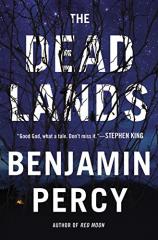The Dead Lands
Review
The Dead Lands
There has been no shortage of post-apocalyptic novels lately, and not just the zombie thrillers we've come to expect. "Serious" writers such as Emily St. John Mandel, Sandra Newman, Laura van den Berg and (later this year) Claire Vaye Watkins have all set their recent books in a country devastated by disease or drought, using these bleak landscapes and desperate conditions to remark obliquely on our own time and place. Now Benjamin Percy has added his own post-apocalyptic narrative to the mix --- and his THE DEAD LANDS might be among the most provocative and frightening examples of the genre yet.
In Percy's novel, not only America but the whole world has been ravaged by a particularly virulent strain of the flu, and to make matters worse, fear over the pandemic precipitated a panicked and ill-reasoned nuclear attack on key cities in the hope that destroying major metropolises might halt the spread of the disease. Instead, the few who escaped the flu still run the risk of succumbing to radiation and cancer, and the animals who were most closely affected by the nuclear radiation have rapidly mutated into what can only be called monsters.
"Benjamin Percy has added his own post-apocalyptic narrative to the mix --- and his THE DEAD LANDS might be among the most provocative and frightening examples of the genre yet."
Those who live in the Sanctuary (formerly known as St. Louis) don't need to worry about monsters or beasts, however. They are protected by two things: an enormous wall impossible to breach, and an authoritarian government that keeps the small but utterly dependent populace in thrall. The rapidly dwindling supply of water is the main concern of everyone. That's one reason why, when a mysterious young woman with bizarre black eyes shows up outside the wall claiming to be from Oregon --- where there's foliage, plenty to eat and more than enough water --- her arrival is seen as a promise to some and a threat to others.
Among the small band joining the young lady (named Gawea) on her journey back to the Northwest are a woman named Clark, her half-brother York, and --- most evocatively --- a reclusive figure named Lewis, who has spent his whole life curating the museum at the Sanctuary. Lewis, like Gawea, seems to have mysterious powers and is summoned by a mysterious figure named Aran Burr, who claims that Lewis, like Gawea, is "the next." The small band's journey is fraught with danger both within and without, and their quest to find a new beginning is interspersed with the account of the Sanctuary's power-mad mayor, who is rapidly losing his grip.
As you've probably noticed by the names of the characters, Percy's novel is inspired by the historical journey of Lewis and Clark, and careful readers will enjoy seeing the parallels he plants and considering how he is playfully rewriting history into the (hopefully) distant future. On a broader level, however, the original journey of Lewis and Clark, and the stories that were written and told about it, were really stories about the expansion and development of what was, then, a relatively young country. Similarly, THE DEAD LANDS considers what it takes to build a society, to claim a wild and dangerous land as one's own, to construct anything resembling a national identity when the nation itself has been perhaps irreparably damaged.
Heavy stuff, no doubt, but did I mention that there are also bats as big as humans? And a weirdly endearing clockwork owl? The juxtaposition between these bizarre, at times nightmarish, images and details, and the broader philosophical underpinnings of Percy's story, is what makes THE DEAD LANDS both thoroughly enjoyable and eminently worthwhile.
Reviewed by Norah Piehl on April 24, 2015
The Dead Lands
- Publication Date: February 23, 2016
- Genres: Fiction, Post-Apocalyptic Fiction, Suspense, Thriller
- Paperback: 416 pages
- Publisher: Grand Central Publishing
- ISBN-10: 1455528234
- ISBN-13: 9781455528233





